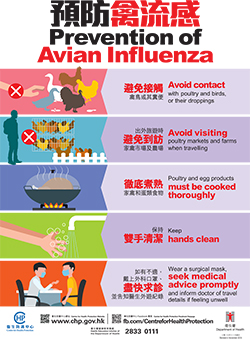The Alert Response Level under the Government's Preparedness Plan for Influenza Pandemic is activated
Avian influenza is caused by those influenza viruses that mainly affect birds and poultry, such as chickens or ducks. Illness in humans from avian influenza virus infections have ranged in severity from no symptoms or mild, flu-like symptoms (e.g. fever, cough, sore throat, muscle aches) to severe respiratory disease (e.g. chest infection) that resulted in multi-organ failure and even death. Eye infection (conjunctivitis), gastrointestinal symptoms (e.g. nausea, vomiting and diarrhoea) and neurological symptoms (e.g. seizures) have also been reported. The incubation period ranges from 1 to 10 days depending on the specific subtypes of avian influenza A viruses. Disease severity will depend upon the subtype of avian influenza virus causing the infection and the characteristics of the infected individual. People mainly become infected with avian influenza virus through contact with infected birds, poultry or other animals (live or dead), or contaminated surfaces with saliva, mucous and animal faeces or environments (such as wet markets and live poultry markets). Human-to-human transmission is inefficient. People in close contact with poultry are more susceptible to contracting avian influenza. The elderly, children and people with chronic illness have a higher risk of developing complications such as bronchitis and chest infection. For details, please refer to the factsheet of Avian Influenza.
For other languages [हिन्दी (Hindi), नेपाली (Nepali), اردو (Urdu), ไทย (Thai), Bahasa Indonesia, Tagalog, Tiếng Việt (Vietnamese), ਪੰਜਾਬੀ (Punjabi)], please click here
|
||||||||||||||||
